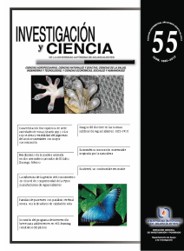Caracterización fisicoquímica de siete variedades de tuna (Opuntia spp.) color rojo-violeta y estabilidad del pigmento de las dos variedades con mayor concentración
DOI:
https://doi.org/10.33064/iycuaa2012554049Palabras clave:
variedades de tuna producidas en México, Opuntia spp., caracterización físico-química, frutos de tuna, estabilidad de betalaínas, pigmentos naturalesResumen
Se evaluaron las características físico-químicas de frutos de siete variedades de tuna (Opuntia spp.) que se producen en México, y la estabilidad del pigmento (betalaínas) de dos de ellas fue monitoreado durante 91 días bajo almacenamiento en tres niveles de pH y dos temperaturas. El intervalo de los valores fue registrado para las variables: contenido de agua (81.34-85.29 g 100 g-1 de
peso fresco (PF)), cenizas (0.48-0.57 g 100 g-1 PF), proteína (0.20-0.39 g 100 g-1 PF), grasa (0.13-0.83 g 100 g-1 PF), fibra cruda (0.33-0.72 g 100 g-1 PF), sólidos solubles totales (9.67-14.12 ºBrix), acidez titulable (0.020-0.074 g 100 g-1 PF) y pH (3.32-5.81). La concentración del pigmento tuvo una amplia variación entre las variedades: Pintadera tuvo la mayor concentración (86.69 mg betanina 100 g-1 PF), seguida de Tapón Aguanoso (58.12 mg betanina 100 g-1 PF).
Descargas
Citas
• Acree, T.E.; Lee, C.Y.; Butts, R.M.; Barnard, J., Geosmin, the earthy component of table beet odor. Journal of Agricultural and Food Chemistry, 24: 430-431, 1976.
• AOAC, Official Methods of Analysis. 15th, U.S.A.: Association of Official Analytical Chemists. 1990.
• BARBERA, G.; INGLESE, P.; LA MANTIA, T., Seed content and fruit characteristics in cactus pear (Opuntia ficus-indica (L.) Miller). Sciencia Horticulturae, 58: 161-165, 1994.
• CASTELLANOS SANTIAGO, E.; YAHIA, E.M., Identification and quantification of betalains from the fruits of 10 mexican prickly pear cultivars by high-performance liquid chromatography and electrospray ionization mass spectrometry. Journal of Agricultural and Food Chemistry, 56: 5758-5764, 2008.
• CASTELLAR, M.R.; OBÓN, J.M.; ALACID, M.; FERNÁNDEZ LÓPEZ, J.A., Color properties and stability of betacyanins from Opuntia fruits. Journal of Agricultural and Food Chemistry, 51: 2772-2776, 2003.
• CASTELLAR, M.R.; OBÓN, J.M.; ALACID, M.; FERNÁNDEZ LÓPEZ, J.A., The isolation and properties of a concentrated red-purple betacyanin food colourant from Opuntia stricta fruits. Journal of the Science of Food and Agriculture, 86(1): 122-128, 2006.
• FERNÁNDEZ LÓPEZ, J.A.; ALMELA, L., Application of high-performance liquid chromatography to the characterization of the betalain pigments in prickly pear fruits. Journal of Chromatography A., 913 (1-2): 415-420, 2001.
• FORNI E.; POLESTELLO A.; MONTEFIORI D.; MAESTRELLI, A., High-performance liquid chromatographic analysis of the pigments of blood-red prickly pear (Opuntia ficus indica). Journal of Chromatography A., 593(1-2): 177-183, 1992.
• GUERRERO, M.P.; ZAVALETA, M.H.A.; BARRIENTOS, P.A.F.; GALLEGOS, V.C.; NÚÑEZ, C.C.A.; VALADEZ, M.E.; CUEVAS, S.J.A., Técnica para el estudio de la micromorfología interna de semillas duras en Opuntia. Revista Fitotecnia Mexicana, 29(2): 37-43, 2006.
• HERBACH, K.M.; STINTZING, F.C.; CARLE, R., Betalain stability and degradation-structural and chromatic aspect. Journal of Food Science, 71(4): 41-49, 2006.
• Hernández Pérez, T., Carrillo López, A., Guevara Lara, F., Cruz Hernández, A.; Paredes López, O., Biochemical and nutritional characterization of three prickly pear species with different ripening behavior. Plant Foods for Human Nutrition, 60(4): 195-200, 2005.
• INGLESE, P.; BARBERA, G.; LA MANTIA, T.; PORTOLANO, S., Crop production and ultimate size of cactus fruit following fruit thinning. HortScience, 30: 227-230, 1995.
• KUTI, J.O.; GALLOWAY, C.M., Sugar composition and invertase activity in prickly pear fruit. Journal of Food Science, 59(2): 387-388, 1994.
• MARTÍNEZ, F.R., Monografía de nopal tunero. México: Secretaría de Desarrollo Rural del Estado de Puebla, 2007.
• Minolta Corporation Manual. Precise color communication. Ramsey, NJ: Minolta Corporation Instrument System Division, 1994.
• Pelayo Zaldívar, C.; Castillo Ánimas, D.; Chatelain Mercado, S.; Siade Barquet, G., Manejo poscosecha de la nochitli o tuna (Opuntia spp.). México: Universidad Autónoma Metropolitana-Iztapalapa, 2010.
• PIGA, A., Cactus pear: a fruit of nutraceutical and functional importance. Journal of the Professional Association for Cactus Development, 6: 9-20, 2004.
• REYNOSO, R.; GARCÍA, F.A.; MORALES, D.; GONZÁLEZ DE MEJIA, E., Stability of Betalain Pigments from a Cactaceae Fruit. Journal of Agricultural and Food Chemistry. 45(8): 2884-2889, 1997.
• SÁENZ, C., Processing technologies: an alternative forcactus pear (Opuntia spp.) fruits and cladodes. Journal of Arid Environments. 46(3): 209-225, 2000.
• SÁENZ, C.; SEPÚLVEDA, E., Cactus-pear juices. Journal of the Professional Association for Cactus Development, 4(3-10), 2001.
• SAPERS, G.M.; HORNSTEIN, J.S., Varietal differences in colorant properties and stability of red beet pigments. Journal of Food Science. 44(4): 1245-1248, 1979.
• SAWAYA, W.N.; KHATCHADOURIAN, H.A.; SAFI, W.M.; AL-MUHAMMAD, Chemical characterization of prickly pear pulp, Opuntia ficus-indica, and the manufacturing of prickly pear jam. International Journal of Food Science & Technology, 18(2): 183-193, 1983.
• SEPÚLVEDA, E., Cactus pear fruit potential for industrialization. In: Sáenz C, editor. Proceedings of the International Symposium: cactus pear and nopalitos processing and uses (pp. 17-21). Santiago, Chile, 1998.
• STINTZING, F.C.; HERBACH, K.M.; MOßHAMMER, M.R.; CARLE, R.; YI, W.E., SELLAPPAN, S.; AKOH, C.C.; BUNCH, R.; FELKER, P., Color, betalain pattern and antioxidant properties of cactus pear (Opuntia sp.) clones. Journal of Agricultural and Food Chemistry, 53(2): 442-451, 2005.
• STINTZING, F.C.; SCHIEBER, A.; Carle, R., Phytochemical and nutritional significance of cactus pear. European Food Research and Technology. 212(4): 396-407, 2001.
• STRACK, D.; VOGT, T.; SCHLIEMANN, W., Recent advances in betalain research. Phytochemistry. 62(3): 247-269, 2003.
• VILORIA MATOS, A.; CORBELLI-MORENO, D.; MORENO ÁLVAREZ, M.J.; BELEN C., Stability in betalains from tuna pulp (Opuntia boldinghii Br. et R.) submitted to a lyophilization process. Revista de la Facultad de Agronomía, 19: 324-331, 2002.
• WYBRANIEC, S.; PLATZNER, I.; GERESH, S., GOTTLIEB, H.E.; HAIMBERG, M.; MOGILNITZKI, M.; MIZRAHI, Y., Betacyanins from vine cactus Hylocereus polyrhizus. Phytochemistry, 58(8): 1209-1212, 2001.
Descargas
Publicado
Cómo citar
Licencia
Derechos de autor 2012 Elia Nora Aquino Bolaños, Yazmín Chavarría Moctezuma, José Luis Chávez Servia, Rosa Isela Guzmán Gerónimo, Eryck R. Silva Hernández, Iñigo Verdalet Guzmán

Esta obra está bajo una licencia internacional Creative Commons Atribución-NoComercial-CompartirIgual 4.0.
Las obras publicadas en versión electrónica de la revista están bajo la licencia Creative Commons Atribución-NoComercial-CompartirIgual 4.0 Internacional (CC BY-NC-SA 4.0)









